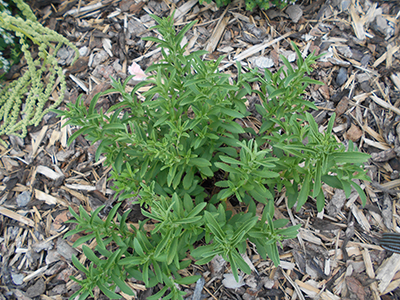Stevia rebaudiana




| ENG | Stevia rebaudiana or Candyleaf |
| SK | Stévia cukrová |
| CZ | Stévie sladká |
| PL | Stewia |
| HU |
Taxonomic characteristic
Family: Asteraceae, Tribe: Eupatorieae, Genus: Stevia
Using
Stevia rebaudiana is a plant species in the genus Stevia spp. of the sunflower family (Asteraceae), commonly known as candy leaf, sweet leaf, sweet leaf, or sugarloaf. Stevia is grown commercially in many parts of Brazil, Paraguay, Uruguay, Central America, Israel, Thailand, and China, for its sweet leaves, which are the source of sweetener products known generically as stevia and sold under various trade names.
The active compounds are various steviol glycosides (mainly stevioside which is 300 times sweeter than sucrose). The leaf is used for diabetes, obesity, cavities, hypertension, fatigue, depression, sweet cravings, and infections. Additionally extract of stevia have vasodilatory activity and deemed it effective for various skin diseases (acne, heat rash, pruritis).
Botanical charakteristic
Stevia is a perennial genus native to subtropical and tropical regions from western North America to South America. S. America - Brazil, Paraguay that favours humid, wet environments, although the root does not tolerate standing water.
It is a perennial semi-shrub up to 30 cm in height. Leaves are sessile, 3-4 cm long, elongate-lanceolate or speculate shape with blunt-tipped lamina, serrate margin from the middle to the tip and entire below. The upper surface of the leaf is slightly glandular pubescent. The stem is weak-pubescent at bottom and woody. The rhizome has slightly branching roots. Flowers are composite surrounded by an involucre of epicalyx. Capitula are in loose, irregular, sympodial cymes. The flowers are light purple, pentamerous. Fruit is a five-ribbed spindle-shaped achene.
Why to have the plant in your garden:
Stevia is approved as a food additive and sugar substitute. It is rich in terpenes and flavonoids. The leaves can be eaten fresh, or put in teas and foods.
Text:
Ing. Ján Farkaš, SUA, Nitra, Slovak Republic
Photo:
Dr. Ivana Mezeyová, Dr. Ján Mezey, SUA, Nitra, Slovak Republic
Links to scientific articles
https://en.wikipedia.org/wiki/Stevia_rebaudiana

